In recent medical history, we’ve witnessed numerous groundbreaking treatments that have transformed patient care. Yet, few have been as intriguing and revolutionary as the synergy between Cerebral Palsy and Botox. At this intersection, where a neurological disorder meets a therapeutic agent, we find hope, relief, and a testament to human ingenuity. As we delve deeper into the nuances of this treatment, it becomes evident how it has not only changed the narrative for countless individuals living with Cerebral Palsy but also underscored the endless possibilities of modern medicine.
Understanding Cerebral Palsy
Cerebral Palsy (CP) stands as one of the most prevalent neurological disorders affecting children worldwide. To truly grasp its significance and its challenges, it’s essential to understand its underlying causes, manifestations, and the overall impact on affected individuals.
Origin and Causes
Cerebral Palsy is primarily rooted in irregularities or injuries in the brain, occurring during its developmental phase. These disruptions, whether they arise from genetic mutations, infections during pregnancy, traumatic head injuries, or a lack of oxygen at birth, can lead to a spectrum of motor disabilities.
Symptoms and Manifestations
The symptoms of CP are diverse and can range in severity. They’re generally characterized by motor and postural dysfunctions, but the specific manifestations can differ vastly among individuals. Common signs include:
- Involuntary movements or tremors
- Stiff or spastic muscles
- Difficulty in walking or asymmetrical gait
- Challenges with coordination and motor skills
- Muscle weakness or atrophy
- Issues with balance and reflexes
Types of Cerebral Palsy
Broadly categorized, CP can be of several types based on the kind of motor dysfunction:
- Spastic CP: The most common form, characterized by muscle stiffness and exaggerated reflexes.
- Dyskinetic CP: Here, individuals might face difficulties in controlling the movement of hands, arms, feet, and legs. It can be slow and writhing or rapid and jerky.
- Ataxic CP: This affects balance and depth perception, leading to problems with coordination.
Impact on Daily Life
Beyond the physical challenges, Cerebral Palsy can also pose significant cognitive, communicative, and sensory impairments. These might include challenges in speech, vision, hearing, and intellectual capacities. Many individuals with CP also experience associated conditions like seizures.
While there’s no cure for Cerebral Palsy, advancements in medical science, such as the introduction of Botox as a therapeutic measure, have paved the way for enhancing the quality of life for those affected. As we explore this further, it becomes evident how transformative these treatments can be in providing relief and restoring a semblance of normalcy.

Botox: Beyond Aesthetics
When the term “Botox” is mentioned, the immediate association for many is its cosmetic use, particularly for smoothing out wrinkles and delaying signs of aging. However, Botox, which is derived from the botulinum toxin, has extensive therapeutic applications that extend far beyond the realm of aesthetics. Let’s delve deeper into the diverse and potentially life-changing uses of Botox outside the cosmetic sphere.
Origins and Mechanism
Botox, scientifically termed as Botulinum toxin type A, is produced by the bacteria Clostridium botulinum. It functions by blocking nerve signals in the muscles where it is injected, causing temporary muscle paralysis. This mechanism, which can soften wrinkles in cosmetic applications, is also the key to its therapeutic benefits.
Medical Therapeutic Uses
- Spasticity and Muscle Disorders: For individuals suffering from conditions that lead to muscle spasticity, like Cerebral Palsy or multiple sclerosis, Botox injections can provide significant relief. By reducing muscle stiffness, it aids in improving mobility and reducing pain.
- Chronic Migraines: Patients plagued by chronic migraines have found solace in Botox treatments. Regular injections, especially around the neck and head, can reduce the frequency of these debilitating headaches.
- Hyperhidrosis: Excessive sweating, or hyperhidrosis, can be both uncomfortable and socially challenging. Botox can be used to block the nerves responsible for activating sweat glands, especially in areas like the underarms.
- Overactive Bladder: An overactive bladder can severely impede one’s quality of life. Botox injections help in relaxing the bladder muscles, reducing incontinence and the frequent need to urinate.
- Strabismus (Crossed Eyes): By relaxing the eye muscles, Botox can aid in aligning them, providing an effective treatment for certain cases of strabismus.
- Neck Spasms: Known as cervical dystonia, this condition results in painful neck muscle contractions. Botox can assist in easing this discomfort by paralyzing the problematic muscles.
Safety and Considerations
While Botox has proven to be incredibly versatile in its medical applications, it’s essential to administer it correctly and in appropriate doses. Potential side effects, although rare, can include pain at the injection site, headache, or flu-like symptoms. Always seek treatment from certified professionals and discuss potential risks and benefits.
The multifaceted nature of Botox is a testament to medical innovation. As research continues and applications expand, it’s clear that Botox’s potential goes far beyond skin-deep aesthetics, offering hope and improved quality of life to many.

Botox in Cerebral Palsy Treatment
Cerebral Palsy (CP) remains one of the most common congenital disorders affecting muscle tone, movement, and motor skills. With the diverse challenges presented by this condition, medical professionals continuously seek effective interventions to improve the quality of life for CP patients. Among these interventions, Botox has emerged as a promising tool in managing specific symptoms of Cerebral Palsy.
The Link between CP and Muscle Spasticity
A predominant symptom of CP is muscle spasticity, where muscles remain continuously contracted. This contraction can cause stiffness, impacting a patient’s mobility and causing pain. It’s the neuro-muscular miscommunication that leads to this persistent muscle contraction, and herein lies the potential of Botox as a therapeutic agent.
How Botox Helps in Cerebral Palsy Treatment
Botox, or botulinum toxin, is predominantly recognized for its cosmetic applications in reducing wrinkles and fine lines. However, its therapeutic use in the realm of Cerebral Palsy treatment has garnered significant attention, offering a renewed sense of hope for many patients and caregivers. Here’s an in-depth look at how Botox is making a difference in the management of Cerebral Palsy:
- Targeted Muscle Relaxation: The primary benefit of Botox in treating Cerebral Palsy lies in its ability to relax hypertonic (overly tight) muscles. When injected into specific muscles, Botox blocks the release of the neurotransmitter acetylcholine, which triggers muscle contraction. This leads to a temporary paralysis of the muscle, allowing it to relax and reducing the muscle stiffness commonly experienced by Cerebral Palsy patients.
- Pain Alleviation: Muscle spasticity in Cerebral Palsy patients often results in discomfort and pain. By reducing muscle tightness, Botox can significantly diminish pain levels, enhancing the patient’s overall comfort and quality of life.
- Improved Mobility: The relaxation of muscles post-Botox treatment can lead to enhanced range of motion for many patients. This can be particularly beneficial for those struggling with daily activities, such as walking or holding objects. Over time, regular Botox treatments can facilitate better motor control and coordination.
- Enhanced Physical Therapy Outcomes: For many Cerebral Palsy patients, physical therapy is a pivotal component of their treatment regimen. With reduced muscle spasticity due to Botox injections, patients often find physical therapy sessions to be more productive. The relaxed muscles respond better to stretches and exercises, paving the way for improved functional outcomes.
- Reduction in Contractures: Prolonged muscle spasticity can lead to contractures, where the muscle and tendons shorten, restricting movement. Botox, when used alongside physical therapy, can help in preventing or reducing the severity of these contractures.
- A Non-Invasive Alternative: Surgical interventions are sometimes recommended for severe spasticity in Cerebral Palsy. Botox presents a non-invasive alternative, offering relief from symptoms without the need for surgical procedures.
- Customized Treatment Approach: Botox injections can be tailored to address the specific needs of each patient. The dosage and injection sites can be adjusted based on the severity of spasticity and the muscles affected, ensuring a personalized treatment plan.
In summary, Botox emerges as a versatile tool in the arsenal against Cerebral Palsy. Its ability to target muscle spasticity at its root and offer symptomatic relief positions it as a game-changer in the treatment landscape. While it may not be a cure, Botox certainly plays a pivotal role in enhancing the lives of those with Cerebral Palsy, providing a semblance of normalcy and an improved quality of life.
The Treatment Process
Administering Botox for Cerebral Palsy typically involves the following steps:
- Evaluation: A thorough assessment determines the muscles that need intervention.
- Injection: Botox is injected directly into the identified muscles. The procedure is relatively quick, often completed in a clinic setting.
- Observation and Follow-up: The effects of Botox begin to appear within a few days to two weeks and can last for up to four months. Regular follow-up appointments ensure optimal outcomes and determine the need for subsequent treatments.
Safety and Considerations
It’s vital to understand that while Botox offers substantial benefits, it is not a cure for Cerebral Palsy. It’s an adjunct treatment designed to manage and alleviate symptoms. The procedure should always be administered by experienced professionals, familiar with CP’s complexities. As with any treatment, there can be potential side effects, so it’s crucial to discuss these with a healthcare provider.
Botox has expanded its therapeutic horizon beyond cosmetic applications. In the context of Cerebral Palsy, it presents an innovative approach to managing muscle spasticity, paving the way for enhanced mobility and improved quality of life for many patients. As research continues, the future holds promise for further refining and expanding its role in CP care.

The Procedure: What to Expect
When considering Botox as a treatment option for Cerebral Palsy or any other medical condition, it’s crucial to understand the procedure’s details. This knowledge ensures that patients, caregivers, and their families are well-prepared, informed, and can set realistic expectations.
1. Pre-Procedure Consultation
- Medical History Review: The practitioner will thoroughly review the patient’s medical history to identify any potential contraindications or considerations that might affect the procedure.
- Physical Examination: A detailed examination of the affected muscles will be conducted to pinpoint the precise injection sites.
- Discussion: Expectations, potential outcomes, benefits, risks, and the number of required sessions will be discussed. It’s the perfect time for patients and caregivers to ask questions and voice any concerns.
2. Preparation
- Cleanliness: The targeted area will be cleaned with antiseptic to minimize the risk of infection.
- Positioning: Patients might be asked to lie down or sit in a specific position to provide the best access to the injection sites.
- Anesthesia: Depending on the patient’s comfort and the practitioner’s assessment, a topical anesthetic might be applied to numb the area and reduce discomfort.
3. The Injection Process
- Precision is Key: Using a fine needle, the practitioner will administer Botox directly into the targeted muscles. The depth, angle, and dose are carefully calculated to ensure maximum effectiveness and safety.
- Duration: The entire injection process is relatively quick, often taking between 15 to 30 minutes, depending on the number of injection sites.
4. Post-Procedure
- Observation: After the injections, patients might be observed for a short period to ensure there are no immediate adverse reactions.
- Post-care Instructions: Practitioners will provide guidelines on what to do and what to avoid after the procedure. This may include recommendations like not lying down immediately after the treatment or avoiding rigorous physical activity for a specified period.
- Side Effects: Some patients might experience temporary bruising, swelling, or discomfort at the injection sites. These effects are generally mild and resolve on their own.
5. Follow-up
- Monitoring: It’s essential to monitor the effects of the Botox injections in the days and weeks following the procedure.
- Feedback Session: Patients are often scheduled for a follow-up appointment to discuss the outcomes, address any concerns, and plan future treatments if needed.
The Botox procedure, when used as a treatment modality for conditions like Cerebral Palsy, is a minimally invasive intervention that has shown promising results. Being well-informed about the procedure can help patients and caregivers make confident decisions and optimize outcomes. Proper consultation, expert administration, and consistent follow-up are key components to ensure the treatment’s success.

Safety and Efficacy
In the realm of medical treatments, particularly when introducing foreign substances into the body, two paramount concerns always emerge: safety and efficacy. Are the treatments safe? Do they work as intended without causing undue harm? When discussing Botox in the context of Cerebral Palsy treatment, these questions are equally, if not more, crucial.
1. Clinical Trials and Research
- Evidence-Based: Botox’s use in Cerebral Palsy treatment is backed by numerous clinical trials and research studies. These studies primarily focus on its application in reducing spasticity in muscles affected by the condition.
- Positive Outcomes: The majority of these studies indicate that Botox has been effective in achieving desired outcomes, including reducing muscle tightness and improving range of motion.
2. Safety Profile
- FDA Approval: Botox has received FDA approval for various medical applications, including the treatment of upper limb spasticity in adults and children over two years old, further solidifying its safety credentials.
- Short-term Side Effects: Common side effects are often mild and transient, including pain or bruising at the injection site, headache, or flu-like symptoms. These typically resolve on their own without intervention.
- Rare Side Effects: In infrequent cases, there may be more severe side effects like muscle weakness, vision disturbances, or difficulties in swallowing or breathing. It’s crucial to consult with a healthcare professional immediately if any severe side effects are noticed.
3. Expert Administration
- Specialized Knowledge: Due to the targeted nature of Botox injections, it is imperative that a trained and experienced professional administers them. Their expert knowledge ensures that the Botox is delivered accurately, optimizing efficacy while minimizing potential risks.
- Customization: The amount of Botox administered is tailored to each patient’s specific needs, ensuring that the dosage is both safe and effective.
4. Continuous Monitoring
- Follow-up Appointments: Regular follow-up appointments allow healthcare professionals to monitor the treatment’s effectiveness and ensure that no adverse reactions develop.
- Adjustments: If necessary, subsequent doses can be adjusted based on the patient’s response to treatment, ensuring optimal results.
The safety and efficacy of Botox as a treatment for Cerebral Palsy are well-documented and supported by extensive clinical research. When administered by trained professionals and coupled with regular monitoring, Botox offers a promising therapeutic option for many individuals with Cerebral Palsy, helping them achieve improved muscle function and a better quality of life.

Future Horizons: Botox and Beyond
As we continue to push the boundaries of medical innovation, Botox, primarily associated with cosmetic enhancements, has paved its way to become a pivotal treatment in the world of neurology, particularly for Cerebral Palsy. But the medical journey of Botox doesn’t end here. The future holds promising expansions, innovations, and possibilities that are likely to shape the trajectory of Botox treatments and introduce even more sophisticated alternatives.
1. Advanced Formulations
- Prolonged Duration: Researchers are delving deep into the science of Botox to develop formulations that can offer longer-lasting effects. A more extended duration of action could reduce the frequency of injections, making it more convenient for patients and caregivers.
- Targeted Delivery: Advanced formulations might lead to more localized effects, ensuring that only the intended muscles are affected, thus minimizing unintended side effects.
2. Combined Therapies
- Integrated Treatment Plans: Combining Botox with other treatments, such as physiotherapy, occupational therapy, or even new medications, may offer enhanced results. By addressing multiple facets of Cerebral Palsy simultaneously, patients may see accelerated improvements.
- Technological Integration: The fusion of Botox treatment with technological advancements like AI-driven muscle monitoring could provide real-time feedback, enabling personalized adjustments to therapy plans.
3. Beyond Botox: New Agents on the Horizon
- Alternative Neurotoxins: While Botox has made a significant mark, other neurotoxins are being researched for their potential benefits in treating Cerebral Palsy and other neurological conditions.
- Gene Therapy: With the revolutionary strides in gene editing techniques, there’s potential for therapies that could address the genetic aspects of Cerebral Palsy, providing a more comprehensive approach to treatment.
4. Global Accessibility and Affordability
- Reduced Costs: As research progresses, there’s hope that more affordable versions of Botox or its alternatives will emerge, ensuring that a larger population can access this treatment.
- Global Reach: Initiatives to expand the availability of Botox treatments in developing nations can make it a globally accessible solution for Cerebral Palsy.
5. Enhanced Training and Specialization
- Expertise Building: As Botox’s therapeutic applications expand, there will be a growing demand for specialized training programs for healthcare professionals to ensure safe and effective administration.
- Patient Education: Future endeavors might also focus on better educating patients and caregivers about the benefits, risks, and nuances of Botox treatments, enabling informed decisions.
The horizon for Botox and its role in Cerebral Palsy treatment is bright and expansive. With continuous research, technological advancements, and a commitment to enhancing patient care, the future is bound to introduce transformative solutions that will further uplift the lives of those affected by Cerebral Palsy and various other conditions. The journey of Botox from a cosmetic enhancer to a medical marvel is just the beginning, with much more to explore and discover in the years to come.

Cerebral Palsy and Botox Conclusion
The intersection of Cerebral Palsy and Botox treatment represents a groundbreaking stride in the field of neurological interventions. Cerebral Palsy, a condition once perceived with limited treatment avenues, has witnessed a transformative shift with the integration of Botox. This therapeutic approach not only offers symptomatic relief but also infuses a new lease of hope, enhancing the quality of life for many afflicted individuals.
The journey of Botox, from its origins in aesthetic medicine to its profound impact in neurology, underscores the dynamic evolution of medical science. As we have ventured through the intricacies of Cerebral Palsy and the potential of Botox in its management, it’s evident that this treatment is more than just a transient solution; it’s a testament to human ingenuity and the relentless pursuit of betterment.
While we recognize and celebrate the strides made, it is also crucial to remain anchored in continuous research, patient-centric approaches, and holistic care. The symbiotic relationship between Cerebral Palsy and Botox is just a chapter in the expansive tome of medical advancements. The future beckons with promise, innovations, and possibilities that will further redefine treatment paradigms and elevate patient experiences.
In essence, the story of “Cerebral Palsy and Botox: A Transformative Treatment Approach” is not just about a medical intervention. It’s about resilience, innovation, and the indomitable human spirit that continually seeks to push boundaries for the betterment of humankind.


